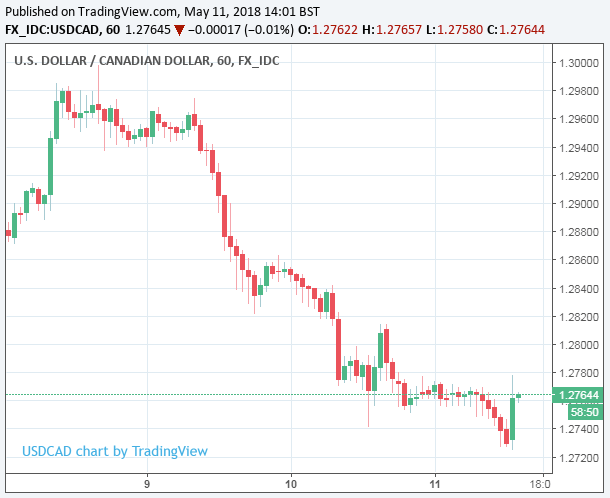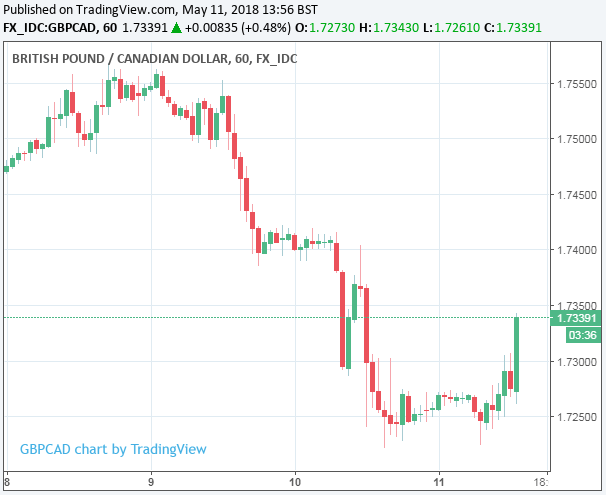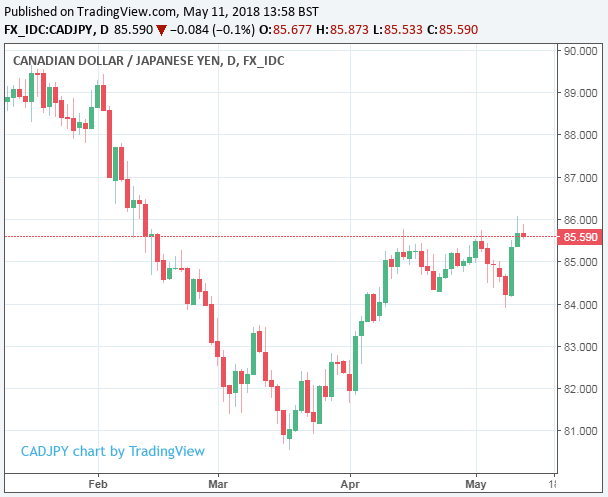The Canadian Dollar Pares Gains after Disappointing April Jobs Data and as Oil-induced Rally Wanes
- Written by: James Skinner
-
-CAD hands back gains after disappointing April employment report.
-CAD jobs growth turns negative but jobless rate holds its 40 Yr low.
-Report follows soft data, comes as traders eye July for next rate hike.

© kasto, Adobe Stock
The Canadian Dollar pared earlier gains in the final session of the week after the latest labour market report showed Canada's economy shedding jobs during the April month when traders had looked for a healthy gain in employment.
Canada's economy shed 1,100 jobs during April, marking a fractional reversal of the 32,000 jobs created back in March, when economists had forecast 17,800 new jobs to have been created during the recent month. Still, this wasn't enough to impact the unemployment rate, which held steady at 5.8%, its joint lowest level for 40 years.
"Canadian employment disappointed on the headline, but the details were fairly solid and shouldn't do much to change expectations regarding the Bank of Canada and future rate hikes. The 1K job loss in April was weaker than the 20K gain expected by the consensus. However, the jobs lost were all part-time (-30K), with full time jobs higher," says Andrew Grantham, an economist at CIBC Capital Markets.
Markets care about jobs data because falling unemployment can have a significant impact on demand and growth within an economy. This means it can also exert influence over inflation and so is pertinent to questions around interest rates, which are themselves the raison d'être for most moves in exchange rates.
Traders are currently looking to the July Bank of Canada meeting for its next rate hike, with interest rate derivative market pricing implying an 88% probability the BoC will raise its cash rate to 1.5% on July 11. Changes in interest rates, or hints of them being in the cards, impact currencies because of the push and pull influence they have on international capital flows and their allure for short-term speculators.

Above: USD/CAD rate shown at hourly intervals.
The USD/CAD rate was quoted 0.06% lower at 1.2765 following the release after paring back an earlier 0.26% loss while the Pound-to-Canadian-Dollar rate was 0.38% higher at 1.7334 after reversing an earlier fractional loss.
The Loonie was also quoted lower against most other developed world currencies after reversing earlier gains.

Above: Pound-to-Canadian-Dollar exchange rate shown at hourly intervals.
Price action comes as the US Dollar continues to ease back from recent highs and the Canadian Dollar attempts to hold its recent oil-induced gains.
These moves were fuelled by a classic "buy the rumour and sell the fact" response to a White House decision to withdraw from the so called Iran nuclear deal and, latterly, slower-than-expected US inflation figures.
"We like the risk-reward of buying USDCAD dips towards 1.27. We also maintain our short CADJPY trade," says Mark McCormick, North American head of FX strategy at TD Securities.

Above: CAD/JPY exchange rate shown at daily intervals.
McCormick and the TD FX team are betting against the Loonie, arguing the currency will fall in value relative to the Japanese Yen over coming weeks.
The Yen, which is a safe haven currency that tends to rise during times of uncertainty, offers traders the opportunity to profit from elevated geopolitical uncertainty as well as a continued weakening of Canadian economic fundamentals.
They entered the trade around 85.10 and is targeting a move down to 81.50, with a stop loss at 86.85.
In addition, and irrespective of all this, the case for a cautious approach toward the Loonie may well remain intact regardless of any changes in the current economic situation on the ground in Canada this Friday.
After all, time is ticking on and talks to renegotiate the North American Free Trade Agreement are yet to bear fruit.
Advertisement
Get up to 5% more foreign exchange by using a specialist provider to get closer to the real market rate and avoid the gaping spreads charged by your bank when providing currency. Learn more here.
NAFTA Talks Still Loom Over the CAD
Canadian, Mexican and US negotiators are in Washington all week attempting to thrash out a deal. However, hopes of a breakthrough have been raised repeatedly in recent months, only to be dashed upon the rocks of reality shortly by fresh disagreement over contentious demands, often from the US.
"If the negotiations really were to drag on until year-end that would no doubt be a bad sign for the Canadian currency. We expect that the USD-CAD exchange rate – driven by a stronger USD – will be under upside pressure in any case over the coming months," says Thu Lan Nguyen, an analyst at Commerzbank, in a recent note.
An eventual deal is important for the Loonie because analysts have previously estimated a withdrawal by the US could see the currency fall by as much as 20%. However, the Mexican presidential election is due in July and US midterm elections are set to become of increasing importance for lawmakers as November approaches.
"We had only expected a very moderate uptrend as we assumed that the Bank of Canada would continue to hike interest rates, thus supporting the currency. But that is by no means certain if the NAFTA uncertainty was to continue and put pressure on the economic outlook," Lan Nguyen adds.
The net effect of deadlock in the negotiations this month could be that talks end up placed on hold until year-end, leaving a key source of uncertainty hang over the head of the Canadian economy, and Dollar, for months longer. This may then deter the Bank of Canada from raising its interest rate again, which would be a further negative for the Loonie, although not all strategists have a bearish view on the currency.
"The rules of origin remains the most contentious and the focus is on the automobile industry as it “governs how much regional content a car must have to qualify for Nafta’s duty-free benefits, and requiring certain portions of a car to be built by people earning higher wages”. Whatever the outcome, higher inflation is highly likely which could bring rate hikes back to the BOC table," says Saktiandi Supaat, an FX strategist at Maybank in Singapore. "We continue to see downside risks to the USDCAD."
Supaat and the Maybank team say the BoC is likely to carry on raising interest rate regardless of what happens with the NAFTA deal and that, when combined with the current "oversold" condition of Canadian Dollar exchange rates, the Loonie may soon come onto a more stable footing. They flag the 1.2720, 1.2638 and 1.2560 levels as likely targets for the USD/CAD exchange rate over the coming weeks.
Advertisement
Get up to 5% more foreign exchange by using a specialist provider to get closer to the real market rate and avoid the gaping spreads charged by your bank when providing currency. Learn more here.









